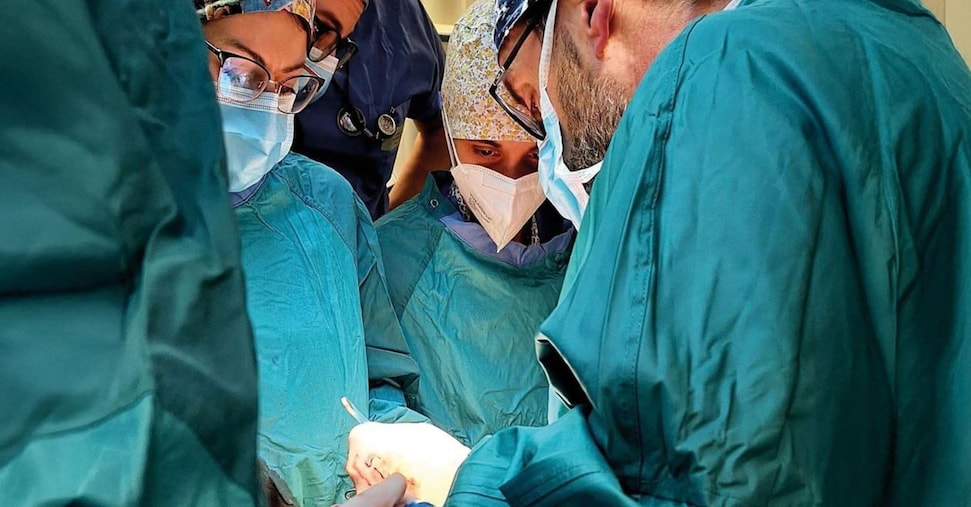Italian Patient Undergoes Complex Liposarcoma Removal, Begins Rehabilitation
gaeta, Italy — A man battling an aggressive form of liposarcoma recently underwent a complex surgical procedure at the Polyclinic to remove a large tumor. The patient, whose identity is being withheld for privacy, is now in rehabilitation, facing a long road to recovery.
Aggressive Tumor Defies Initial Treatments
The patient’s journey began in April 2023 when he underwent his third operation for liposarcoma, a rare cancer that develops in adipose tissue. While the initial surgical removal was performed, the tumor returned aggressively within months. Consequently, he underwent four chemotherapy cycles.
Despite these efforts, the tumor continued to grow.The location and initial size of the mass complex treatment. The chemotherapy, administered at the Polyclinic, aimed to shrink the tumor, but the disease proved resistant. This prompted close monitoring to determine the next course of action.
Emergency hospitalization and Urgent Surgery
in early 2025, the patient’s condition deteriorated, leading to hospitalization in the Polyclinic emergency room. He experienced worsening dyspnea, or difficulty breathing, and ascites, a build-up of fluid in the abdominal cavity. These symptoms indicated a worsening of the tumor and were not merely side effects of the pharmacological treatment.
The fluid accumulation caused increased internal pressure,leading to general discomfort and reduced quality of life. Even basic activities became tiring because of the dyspnea. “This clinical picture pushed the medical team to make the decision to intervene urgently, to avoid the risk of further complications and to contain the progression of the mass,” a hospital spokesperson saeid.
A Delicate and Complex Surgical Intervention
The surgery to remove the liposarcoma was described by the surgical team as “an extremely delicate operation.” The tumor had grown significantly, requiring the expertise of two surgeons to lift and fully remove it. The procedure was performed at the Polyclinic under challenging circumstances but was completed without immediate complications.
Professor Valeri, who led the surgical team, emphasized the procedure’s technical complexity and the critical importance of teamwork. “The success of the intervention is also due to the careful management of all moments, from the preparation to the operating phase, passing through the constant control of the patient’s vital conditions,” Valeri said. “The delicate balance between precision and timeliness has made it possible to complete the removal of the mass without further problems.”
Post-operative Rehabilitation and Recovery
Following the surgery, the patient was transferred to the S. Maria della Provvidenza rehabilitation center of Don Gnocchi, which specializes in post-surgical and oncological rehabilitation.There, he has begun a recovery program involving continual monitoring, supportive therapies, and exercises designed to restore physical functions impaired by the disease and the surgery.
the current therapeutic program aims to stabilize the patient’s clinical condition and minimize the risk of recurrence. So far, there have been no indications of new complications. The collaborative effort between oncologists, physical therapists, and other medical professionals at the center is essential to supporting the patient during this phase.
“However,the attention maintains the supervisory threshold high,considering the clinical history and aggression of the liposarcoma,” the spokesperson added. “in the coming months it will be decisive to observe the response to rehabilitation treatment and evaluate any complementary therapies that can support long -term stabilization.”
liposarcoma: An Overview
Liposarcoma is a type of cancer that arises from fat cells in the body’s soft tissues. It can occur anywhere in the body but is moast common in the limbs and abdomen. The exact cause of liposarcoma is unknown, but genetic factors may play a role. Symptoms can vary depending on the size and location of the tumor but may include a palpable mass, pain, or swelling.
Treatment options for liposarcoma typically include surgery, radiation therapy, and chemotherapy. The prognosis for patients with liposarcoma depends on several factors, including the tumor’s size, location, and grade, as well as the patient’s overall health. Early detection and treatment are crucial for improving outcomes.
| Liposarcoma Subtype | Characteristics | Prognosis |
|---|---|---|
| Well-differentiated | Slow-growing, ofen resembles normal fat tissue | generally good |
| Myxoid | Contains a gelatinous substance | Intermediate |
| Round cell | Aggressive, fast-growing | Poor |
| Pleomorphic | Highly aggressive, contains abnormal cells | Poor |
The Role of rehabilitation in Sarcoma Recovery
Rehabilitation plays a crucial role in the recovery process for patients who have undergone surgery for liposarcoma and other sarcomas. The goals of rehabilitation include restoring function, reducing pain, and improving overall quality of life. Rehabilitation programs may include physical therapy, occupational therapy, and pain management.
Physical therapy can help patients regain strength, flexibility, and range of motion. Occupational therapy can assist patients in adapting to daily activities and returning to work or other meaningful pursuits. Pain management techniques can definitely help patients cope with chronic pain and improve their ability to participate in rehabilitation activities.
Counterargument: Is Surgery Always the Best Option?
While surgery is often the primary treatment for liposarcoma, it’s crucial to acknowledge that it may not always be the optimal choice for every patient. In cases where the tumor is in a difficult-to-reach location or has spread to other parts of the body, surgery may not be feasible or may not offer significant benefits. In these situations, alternative treatments such as radiation therapy, chemotherapy, or targeted therapies may be considered.
Moreover, even when surgery is absolutely possible, it carries inherent risks and potential complications, such as infection, bleeding, and nerve damage.The decision to proceed with surgery should be made on a case-by-case basis, taking into account the patient’s overall health, the characteristics of the tumor, and the potential risks and benefits of all available treatment options. A multidisciplinary approach involving surgeons, oncologists, and other specialists is essential to developing the most appropriate treatment plan for each individual patient.
FAQ: Liposarcoma
- What is liposarcoma?
- Liposarcoma is a rare type of cancer that develops in the fat cells of soft tissue. It can occur anywhere in the body, but it is most common in the limbs or abdomen.
- What are the symptoms of liposarcoma?
- Symptoms of liposarcoma can vary depending on the size and location of the tumor. Common symptoms include a palpable mass, pain, swelling, or pressure in the affected area.
- How is liposarcoma diagnosed?
- Liposarcoma is typically diagnosed through a combination of physical examination, imaging tests (such as X-ray, CT scan, or MRI), and a biopsy of the tumor tissue.
- What are the treatment options for liposarcoma?
- Treatment options for liposarcoma may include surgery, radiation therapy, chemotherapy, or targeted therapy. The specific treatment plan will depend on the size, location, and grade of the tumor, as well as the patient’s overall health.
- What is the prognosis for liposarcoma?
- The prognosis for liposarcoma varies depending on several factors, including the tumor’s size, location, and grade, as well as the patient’s overall health. Early detection and treatment can improve the chances of a successful outcome.
What are the latest advancements in liposarcoma treatment?
Archyde Interview: Professor Emilia Rossi on Liposarcoma Treatment and Rehabilitation
Gaeta, Italy – A discussion on the latest developments in liposarcoma treatment.
Introduction
Welcome to Archyde News. Today, we have the pleasure of speaking with Professor Emilia Rossi, a leading oncologist specializing in sarcoma treatment at the Polyclinic in gaeta. Professor Rossi, thank you for joining us.
Professor Rossi: Thank you for having me. it’s a pleasure to be here.
Understanding Liposarcoma Treatment
Archyde: Professor Rossi,recent reports have highlighted a case of complex liposarcoma removal and subsequent rehabilitation. Can you shed some light on the challenges in treating this aggressive disease?
Professor Rossi: Certainly. Liposarcoma, notably in it’s aggressive forms, presents significant challenges. As the article mentioned, the tumor can be locally advanced and resistant to initial treatments like chemotherapy. The location and size of the tumor also play a crucial roles, as do the different subtypes and their respective prognoses. Early detection and treatment are indeed crucial.
The Surgical procedure
Archyde: The surgery seems to have been particularly delicate. What makes liposarcoma removal so complex, and what were the key factors in the surgical team’s success?
Professor Rossi: Often these tumors are intertwined with vital structures, making precise surgical intervention critical. As Professor Valeri mentioned, a coordinated team approach and meticulous attention to detail, from readiness thru to the patient’s vital signs during the procedure, are imperative. The balance between precision and timeliness is a fundamental aspect.
The Importance of Rehabilitation
Archyde: Post-operative rehabilitation is a significant aspect of recovery. What role does rehabilitation play in the overall recovery process for liposarcoma patients?
Professor Rossi: Rehabilitation is absolutely essential. The goal is not just to control the recurrence and stabilize the patient, as mentioned in the case; it is designed to restore the patient’s functionality, minimize physical limitations, and improve their overall quality of life. Physical therapy, occupational therapy, and pain management are all critical components.
Challenges and Choice Treatments
Archyde: With the evolution of medical science, are there times, when surgery isn’t the optimal treatment? What alternatives are considered?
professor Rossi: Absolutely. In some cases,like when the tumor’s position makes surgery too risky or if it has spread,alternative treatments such as radiation,chemotherapy,or targeted therapies become necessary. The decision to proceed with surgery must be made on an individual patient basis, considering their overall health, tumor characteristics, and the potential risks and benefits of all treatment options.
Long-Term Outlook and Management
Archyde: The article mentions the need for ongoing monitoring. What can patients and their medical teams do to help manage liposarcoma long term?
Professor rossi: Regular check-ups, imaging scans, and adhering to the prescribed treatment plan are vital. Lifestyle changes, such as engaging in regular, moderate exercise as the article suggests, can also substantially improve a patient’s well-being. close collaboration between oncologists, surgeons, physical therapists, and other healthcare professionals is also crucial to support the patient through this phase.
A Conversation Starter
Archyde: Lastly,Professor. Considering advancements in liposarcoma treatment, what strategies do you believe will significantly improve patient outcomes in the next five years?
Professor Rossi: I believe personalized medicine and targeted therapies will be crucial. Further understanding the genetics of liposarcoma will allow us to develop more tailored treatments. This, combined with advancements in surgical techniques and improved rehabilitation protocols, will lead to better outcomes and enhanced quality of life for our patients.
Archyde: Thank you, Professor Rossi, for your in-depth insights.It has been a pleasure speaking with you.
Professor Rossi: The pleasure was all mine.
We encourage our readers to share their thoughts and experiences in the comments section below. What further questions do you have about liposarcoma and its treatment?







